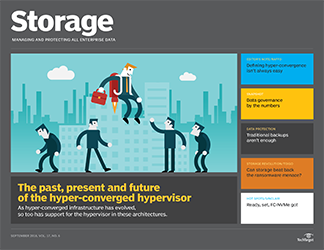PRO+ Premium Content/Storage
Access your Pro+ Content below.
Examples of hypervisors and how they're supported in HCI products

This article is part of the Storage issue of September 2018, Vol. 17, No. 6
Hyper-converged infrastructure has become an increasingly complex segment of the data center architecture market over the last few years. The definition of hyper-convergence has expanded as this technology continues to fracture into more targeted products. One critical aspect of HCI that's evolved over time is hypervisor support. Examples of hypervisors used in hyper-convergence vary. Early iterations of common hyper-converged systems focused on extending the capabilities of offerings from companies such as VMware and, later, Microsoft. Early hyper-converged offerings for VMware vSphere or Microsoft Hyper-V may look and act like modern examples of hypervisors in hyper-converged products, but they were intended to simplify and lower the cost of storage for smaller organizations, and that was pretty much it. But over time, some HCI vendors turned to the open source kernel-based virtual machine (KVM) hypervisor as an alternative. HCI pioneer Nutanix is one of the vendors with its own KVM-based hypervisor, but there are others. ...
Features in this issue
-
Examples of hypervisors and how they're supported in HCI products
Hypervisor support in hyper-converged infrastructure has evolved over time. Find out how as we assess the past and current place of individual hypervisors in these architectures.
-
Data governance best practices exploit big data
Emerging technologies, such as AI and IoT, in the age of big data mean there's more data than ever to benefit from and for data governance policies to manage and secure.
Columns in this issue
-
Definition of hyper-converged infrastructure evolves, as do products
Defining hyper-convergence can be a challenge. Focus instead on learning about hyper-converged infrastructure product options and how they fit your data center and cloud plans.
-
Preventing ransomware attacks is a top storage vendor claim
Storage vendors advance silly and not-so-silly claims about how data backup and protection technologies are the answer to ransomware prevention and growing ransomware fatalism.
